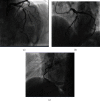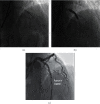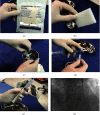Novel Product for the Management of Coronary Ruptures Happening during Percutaneous Coronary Interventions
- PMID: 33628517
- PMCID: PMC7892221
- DOI: 10.1155/2021/6688338
Novel Product for the Management of Coronary Ruptures Happening during Percutaneous Coronary Interventions
Abstract
Coronary artery perforation during percutaneous coronary interventions is a rare but dreaded complication. One of the treatment methods for this complication is the injection of an obliterating material into the ruptured vessel. We will introduce a novel material named "Spongostan" for embolization with significant advantages over available treatment options.
Copyright © 2021 Arash Hashemi et al.
Conflict of interest statement
The authors declare that they have no conflicts of interest.
Figures





Similar articles
-
Late Intervention-Related Complication - A Huge Subepicardial Hematoma.Acta Cardiol Sin. 2013 May;29(3):288-90. Acta Cardiol Sin. 2013. PMID: 27122720 Free PMC article.
-
Successful embolization of iatrogenic ruptured coronary artery using Onyx: a new technique.Acute Card Care. 2014 Dec;16(4):123-6. doi: 10.3109/17482941.2014.944541. Epub 2014 Aug 11. Acute Card Care. 2014. PMID: 25110834
-
Successful closure of coronary artery perforation using non-conventional embolic material.Indian Heart J. 2005 Mar-Apr;57(2):170-1. Indian Heart J. 2005. PMID: 16013360
-
Coronary Artery Perforation Following Percutaneous Coronary Intervention.J Invasive Cardiol. 2016 Mar;28(3):122-31. J Invasive Cardiol. 2016. PMID: 26945255 Review.
-
Treatment of right ventricular perforation during percutaneous coronary intervention.Cardiovasc J Afr. 2015 May 23;26(3):e4-6. doi: 10.5830/CVJA-2014-072. Cardiovasc J Afr. 2015. PMID: 26592991 Free PMC article. Review.
References
-
- Fogarassy G., Apró D., Veress G. Successful sealing of a coronary artery perforation with a mesh-covered stent. The Journal of Invasive Cardiology. 2012;24(4, article E80) - PubMed
-
- Stathopoulos I., Panagopoulos G., Kossidas K., Jimenez M., Garratt K. Guidewire-induced coronary artery perforation and tamponade during PCI: in-hospital outcomes and impact on long-term survival. The Journal of Invasive Cardiology. 2014;26(8):371–376. - PubMed
Publication types
LinkOut - more resources
Full Text Sources
Other Literature Sources

